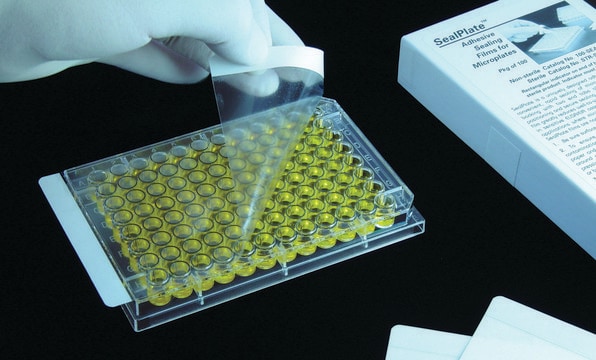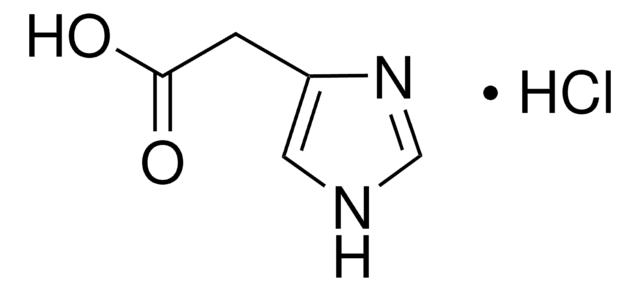D3689
(S)-3,5-Dihydroxyphenylglycine hydrate
≥98% (HPLC), powder
Synonym(s):
S-DHPG
Sign Into View Organizational & Contract Pricing
All Photos(1)
About This Item
Empirical Formula (Hill Notation):
C8H9NO4 · xH2O
CAS Number:
Molecular Weight:
183.16 (anhydrous basis)
MDL number:
UNSPSC Code:
12352209
PubChem Substance ID:
NACRES:
NA.77
Recommended Products
Quality Level
Assay
≥98% (HPLC)
form
powder
storage condition
desiccated
protect from light
color
white
storage temp.
−20°C
SMILES string
O.N[C@H](C(O)=O)c1cc(O)cc(O)c1
InChI
1S/C8H9NO4.H2O/c9-7(8(12)13)4-1-5(10)3-6(11)2-4;/h1-3,7,10-11H,9H2,(H,12,13);1H2/t7-;/m0./s1
InChI key
QZEFIWWBQUKNFA-FJXQXJEOSA-N
Gene Information
human ... GRM1(2911)
Application
(S)-3,5-Dihydroxyphenylglycine hydrate has been used:
- as mGluR1/5 agonist for metabotropic glutamate receptor 1 (mGluR1/5) activation in synaptoneurosomal preparations
- in ACSF for DHPG stimulation
- to inject into basolateral amygdala to study its effect on memory expression
Biochem/physiol Actions
(S)-3,5-Dihydroxyphenylglycine hydrate is a group I metabotropic glutamate receptor agonist.
Features and Benefits
This compound is a featured product for Neuroscience research. Click here to discover more featured Neuroscience products. Learn more about bioactive small molecules for other areas of research at sigma.com/discover-bsm.
This compound is featured on the Glutamate Receptors (G Protein Family) page of the Handbook of Receptor Classification and Signal Transduction. To browse other handbook pages, click here.
Caution
air sensitive
Signal Word
Warning
Hazard Statements
Precautionary Statements
Hazard Classifications
Eye Irrit. 2 - Skin Irrit. 2 - STOT SE 3
Target Organs
Respiratory system
Storage Class Code
11 - Combustible Solids
WGK
WGK 3
Flash Point(F)
Not applicable
Flash Point(C)
Not applicable
Personal Protective Equipment
dust mask type N95 (US), Eyeshields, Gloves
Choose from one of the most recent versions:
Already Own This Product?
Find documentation for the products that you have recently purchased in the Document Library.
Infantile amnesia reflects a developmental critical period for hippocampal learning
Travaglia A, et al.
Nature Neuroscience, 19(9), 1225-1225 (2016)
Cell-Type-Specific Translation Profiling Reveals a Novel Strategy for Treating Fragile X Syndrome
Thomson SR, et al.
Neuron, 95(3), 550-563 (2017)
Overexpression of STIM1 in neurons in mouse brain improves contextual learning and impairs long-term depression
Majewski L, et al.
Biochimica et Biophysica Acta - Molecular Cell Research, 1864(6), 1071-1087 (2017)
Patrick K McCamphill et al.
Science translational medicine, 12(544) (2020-05-22)
Fragile X syndrome is caused by FMR1 gene silencing and loss of the encoded fragile X mental retardation protein (FMRP), which binds to mRNA and regulates translation. Studies in the Fmr1-/y mouse model of fragile X syndrome indicate that aberrant
Jing-Jing Zhou et al.
Neuropharmacology, 174, 108159-108159 (2020-05-27)
The hypothalamic paraventricular nucleus (PVN) plays a major role in generating increased sympathetic output in hypertension. Although group III metabotropic glutamate receptors (mGluRs) are expressed in the hypothalamus, little is known about their contribution to regulating PVN presympathetic neurons in
Our team of scientists has experience in all areas of research including Life Science, Material Science, Chemical Synthesis, Chromatography, Analytical and many others.
Contact Technical Service








